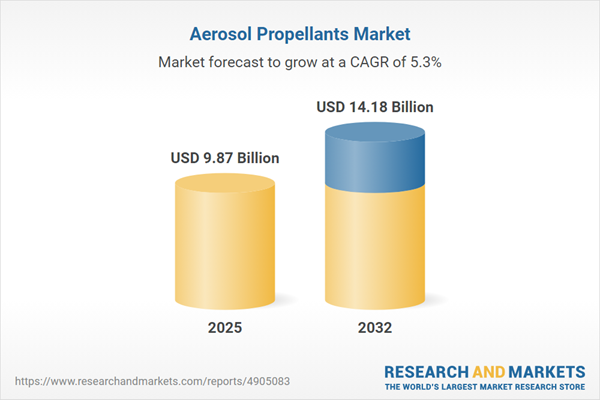Speak directly to the analyst to clarify any post sales queries you may have.
The aerosol propellants market is undergoing significant transformation, shaped by regulatory adjustments, evolving sustainability mandates, and supply chain innovation. Senior decision-makers must balance operational agility, compliance, and strategic positioning to remain competitive in this dynamic landscape.
Aerosol Propellants Market Snapshot
The global aerosol propellants market maintains a steady growth trajectory, driven by widespread adoption across both industrial and consumer segments. Key applications, including household cleaning, automotive maintenance, and personal care, benefit from the reliability and efficiency of aerosol delivery methods. New formulation and packaging technologies continue to support market expansion, enabling stakeholders to address end-user safety, regulatory requirements, and improved product handling. As compliance expectations tighten, industry leaders are prioritizing internal upgrades and forging collaborative partnerships aimed at consolidating their market positions and preparing for emerging shifts in sector regulations and supply chain practices.
Scope & Segmentation of the Aerosol Propellants Market
- Propellant Types: Compressed gases such as air, nitrogen, and carbon dioxide, together with hydrocarbon variants including isobutane, n-butane, and propane, are widely used. Emerging options like dimethyl ether and hydrofluoroalkane blends illustrate industry commitment to sustainable practices and regulatory alignment across product categories.
- Container Materials: Packaging options include aluminum, plastic, and tin-plated steel. Selection criteria are increasingly influenced by safety, durability, and alignment with environmental, social, and governance (ESG) standards, supporting operational efficiency and reduced environmental impact.
- Applications: The scope of aerosol propellants extends to personal care, household cleaning, food preparation, automotive, and industrial sectors. Each area commands attention to specific safety and performance benchmarks, shaping procurement guidelines and product development strategies.
- Distribution Channels: Market participants utilize multichannel approaches, including e-commerce, direct supply for sectors such as hospitality and public services, and entrenched retail networks. This diversity supports supply resilience and flexible procurement strategies, benefitting both suppliers and end-users.
- Regional Coverage: The market operates across the Americas, EMEA, and Asia-Pacific. Regional frameworks impact technology adoption, shape compliance strategies, and define distinct growth pathways due to policy variations and market maturity.
- Key Companies Profiled: Influential industry participants include Honeywell International Inc., The Chemours Company, Arkema S.A., Shanghai HuaYi Group Co., Ltd., Solvay S.A., Linde plc, Air Liquide S.A., Air Products and Chemicals, Inc., Koura Global, Inc., and Orbia Advance Corporation, S.A.B. de C.V. Their actions guide standards and sector innovation.
Aerosol Propellants Market: Key Takeaways for Senior Leaders
- Ensure product design and packaging development are closely aligned with current and upcoming regulatory and ESG obligations to fortify compliance and minimize operational risk.
- Steer investments towards sustainable propellant solutions to meet evolving regulations and unlock new opportunities for industry partnerships and market expansion.
- Advance digital transformation within the supply chain to enable organizational agility and enhance cost management as policy landscapes evolve.
- Utilize digital analytics for comprehensive oversight of compliance processes, facilitating reliable operations and streamlined workflows for geographically distributed teams.
- Strengthen supplier collaboration frameworks to accelerate speed-to-market, enhance compliance efficiency, and bolster resilience against supply chain challenges.
- Deploy advanced digital controls to protect intellectual property while aligning with market and regulatory developments in the aerosol propellants sector.
Tariff Impact on the Aerosol Propellants Supply Chain
Recent tariff changes affecting U.S. chemical inputs have led aerosol propellant manufacturers to revisit procurement and sourcing strategies. Many firms have pivoted toward nearshoring models to reduce trade risk and maintain continuity of supply. Enhanced transparency through digital sourcing and greater cooperation between procurement, production, and R&D divisions support greater operational resilience and cost efficiency as trade and tariff policy continues to shift.
Methodology & Data Sources
This analysis utilizes extensive desk research, structured expert interviews, and direct feedback from procurement professionals. The actionable insights presented are supported by transactional analysis and patent benchmarking, ensuring that executive teams receive reliable guidance when assessing strategic directions in the aerosol propellants market.
Why This Report Matters for Leadership Teams
- Enables organizations to adapt quickly to regulatory changes, supporting ongoing compliance and effective risk mitigation strategies.
- Delivers clear, actionable intelligence and thorough risk analysis, empowering senior executives to initiate sustainable growth and resilient operational practices.
- Provides business leaders with structured guidance to achieve operational excellence and continuity as the aerosol propellants landscape evolves.
Conclusion
With existing and forthcoming industry changes, ongoing digitalization and robust compliance measures are central to navigating the aerosol propellants market. This report equips senior leadership with strategic insights for confident, future-proof decisions.
Additional Product Information:
- Purchase of this report includes 1 year online access with quarterly updates.
- This report can be updated on request. Please contact our Customer Experience team using the Ask a Question widget on our website.
Table of Contents
3. Executive Summary
4. Market Overview
7. Cumulative Impact of Artificial Intelligence 2025
Companies Mentioned
The companies profiled in this Aerosol Propellants market report include:- Honeywell International Inc.
- The Chemours Company
- Arkema S.A.
- Shanghai HuaYi Group Co., Ltd.
- Solvay S.A.
- Linde plc
- Air Liquide S.A.
- Air Products and Chemicals, Inc.
- Koura Global, Inc.
- Orbia Advance Corporation, S.A.B. de C.V.
Table Information
| Report Attribute | Details |
|---|---|
| No. of Pages | 191 |
| Published | October 2025 |
| Forecast Period | 2025 - 2032 |
| Estimated Market Value ( USD | $ 9.87 Billion |
| Forecasted Market Value ( USD | $ 14.18 Billion |
| Compound Annual Growth Rate | 5.3% |
| Regions Covered | Global |
| No. of Companies Mentioned | 11 |









